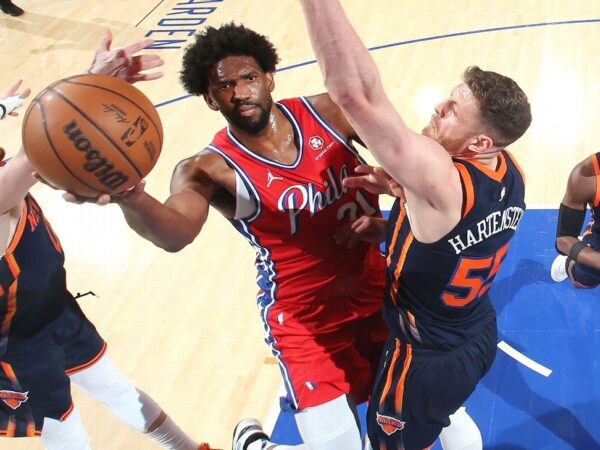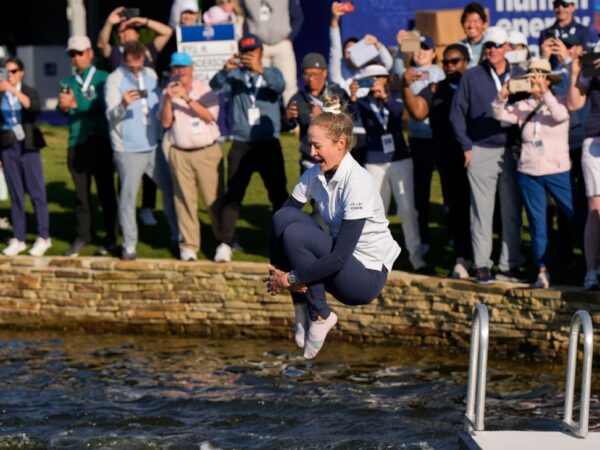LYON, France — The rest of the world will have its turn. But not here. Not yet.
In a Women’s World Cup marked by European success, the United States is the last team standing. Slow at the start for the first time, the U.S. women came to life in the second half to beat the Netherlands 2-0 on Sunday on second-half goals from Megan Rapinoe and Rose Lavelle.
The fourth title overall for the United States also marks the first time it won back-to-back trophies.
Rapinoe won the Golden Boot as the tournament’s top scorer and the Golden Ball as its top player. Alex Morgan won the Silver Boot.
Megan Rapinoe makes her mark where Lieke Martens can’t
The biggest question going into the final was the health of two stars, after Rapinoe missed the semifinal with a hamstring injury and Martens left at halftime of Netherlands’ semifinal with a foot injury.
Both started the final. Neither finished the final. That was where the similarities ended.
Rapinoe didn’t play the game of her life. She looked at times like someone whose touch was half a beat off after missing training. But she put the ball in dangerous spots multiple times in the first half, denied only by Sari van Veenendaal’s goalkeeping. And with the ball on the penalty spot in the 61st minute, Rapinoe calmly finished her third penalty in as many tries this World Cup.
The goal tied her with Morgan and England’s Ellen White for the tournament lead.
The first woman to start three consecutive World Cup finals, Rapinoe will go down as the face of this tournament — and the voice of this tournament. Sunday wasn’t quite the capstone that Carli Lloyd enjoyed four years ago with a hat trick in the 2015 final in Canada, but it was more than enough.
Rose Lavelle is bound for bigger things
What we’ll remember is the goal, but there was much more than that.
Perhaps the most impressive moment for Lavelle in this World Cup came when she talked about her performance in the quarterfinal with France. Granted, the U.S. women survived that game, so there wasn’t guilt involved in the days after, but it’s not often you hear a player pull out the word “atrocious” when talking about her own play. All the more for someone playing in her first World Cup in her early 20s. The point being, Lavelle kept a pretty even keel for such a big stage.
And after a strong semifinal performance against England, she was good from the start in the final. Whether it was dropping back into a left back position to cover for Kelley O’Hara at times or chasing 50 yards back to blow up counters (albeit sometimes off her own turnovers), Lavelle, who won the Bronze Ball as one of the tournament’s top players after scoring three goals in six games, was always easy to spot because she was right in the middle of the action.
Then came the 30-yard run with the ball. The Dutch defenders retreated and retreated, she made one quick touch to her left to get past Stefanie van der Gragt, then shot back in the direction she came from. The United States waited a long time for Lavelle to shake up its midfield, showing patience as she battled injuries after a sensational debut in 2017. It was well worth the wait for a rising star.
VAR makes its mark in World Cup final
Sunday was the first World Cup final for the Netherlands and the first for about half of the U.S. starting lineup. Almost an hour into the game, VAR made its debut, too.
After having more of the ball in the opening half without getting anything past van Veenendaal, the U.S. women were struggling to come up with a cohesive attack in the second half when Tobin Heath sent in a cross from the right side. The ball deflected off a Dutch player and floated toward Morgan. That was when van der Gragt, perhaps trying to get her bearings on the redirected ball, lifted a boot high toward the ball but made contact only with Morgan’s arm. The referee initially signaled for a corner kick, but as fans chanted “V-A-R” she signaled that the VAR officials had advised her to review the play.
Considering van der Gragt missed the ball and her cleats made contact with Morgan’s arm, replays left Stephanie Frappart little choice but to point to the spot for a penalty.
No quick start for the United States
The streak of early goals was going to end at some point, no matter how well the U.S. women played. The Americans scored inside of 15 minutes in each of their first six games, and the sport just doesn’t work that way for even the greatest teams. But it wasn’t bad luck or bad bounces that stopped the United States early in this game. The Americans just didn’t play very well.
Julie Ertz got caught up field, leaving too much space for the Dutch to counter. O’Hara was called for a foul throw. Rapinoe couldn’t skip past a defender on the left side and jogged after the play. Abby Dahlkemper launched one of her normally pinpoint cross-field long balls … right into the arms of van Veenendaal, who won the Golden Glove as the tournament’s top goaltender. There was not only a lack of precision, but even the energy seemed off in those opening minutes.
The upside for the United States was that the Dutch seemed willing to absorb and take their chances later, launching only a couple of dangerous counters in that time. They came to regret that.
Ali Krieger gets her moment when the United States needs it
Ali Krieger is one of the most positive people you’re likely to encounter in any walk of life, someone who forged her own path playing professionally in Germany after dealing with a serious medical issue during her time at Penn State. But she admitted before this World Cup that being dropped from the U.S. team after the 2016 Olympics took her to a dark place.
She didn’t know why she was out of the mix. She didn’t know what it would take to get back in, as the United States auditioned young outside back after young outside back for the role she filled in both the 2011 and 2015 World Cup finals. Finally, with only weeks to go until this World Cup, she got the call from Jill Ellis. With no obvious replacements seizing their chance, Ellis settled for the veteran presence. It paid off Sunday afternoon. So did Krieger’s perseverance.
With O’Hara out of the game at halftime, presumably related to a head-to-head collision with Martens near the end of the half, Krieger warmed up while the rest of the team was in the locker room, then came on and did her job for 45 minutes.
Was it a star turn? No. But it was what the U.S. women needed.
Source:ESPN











